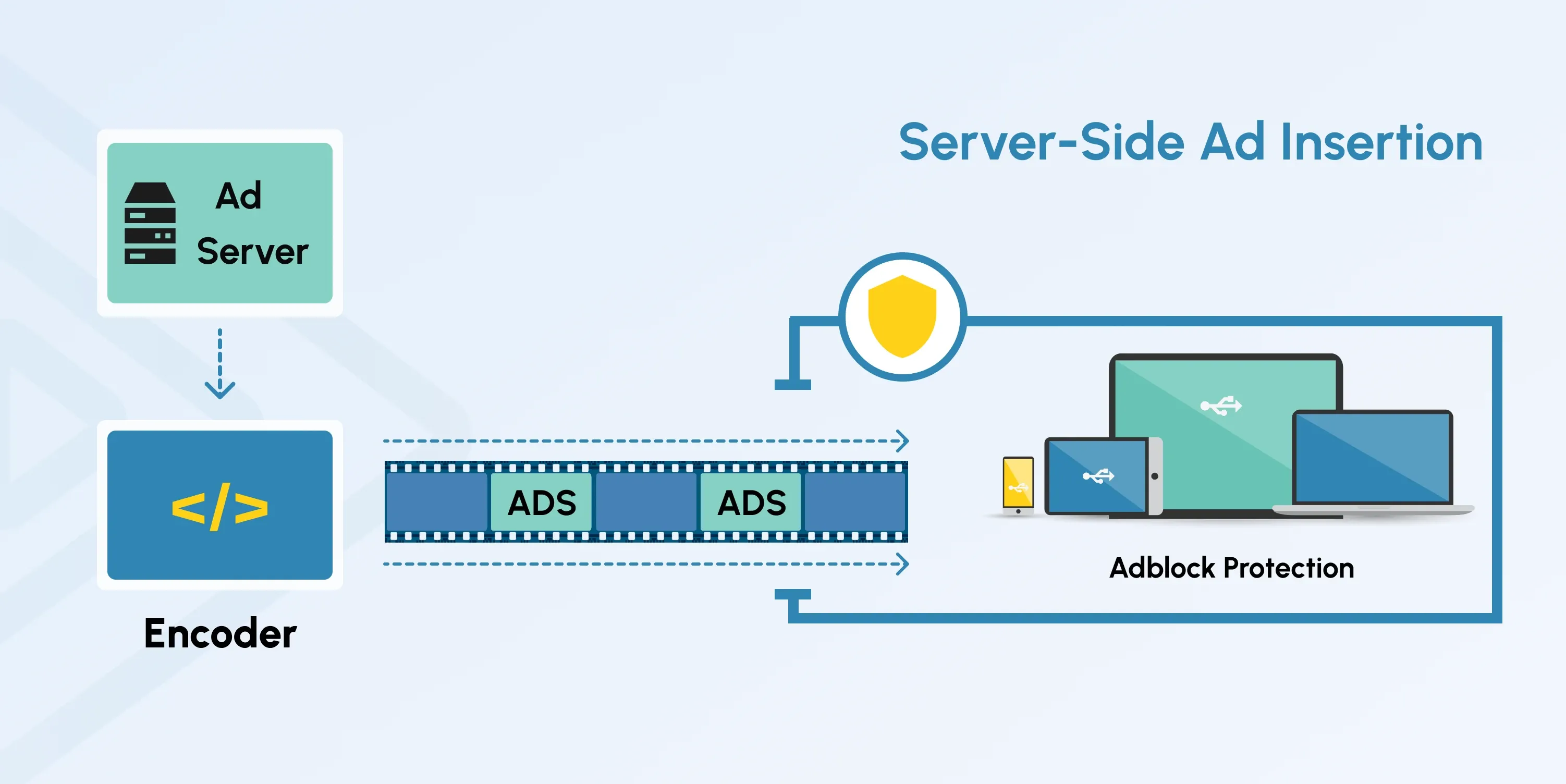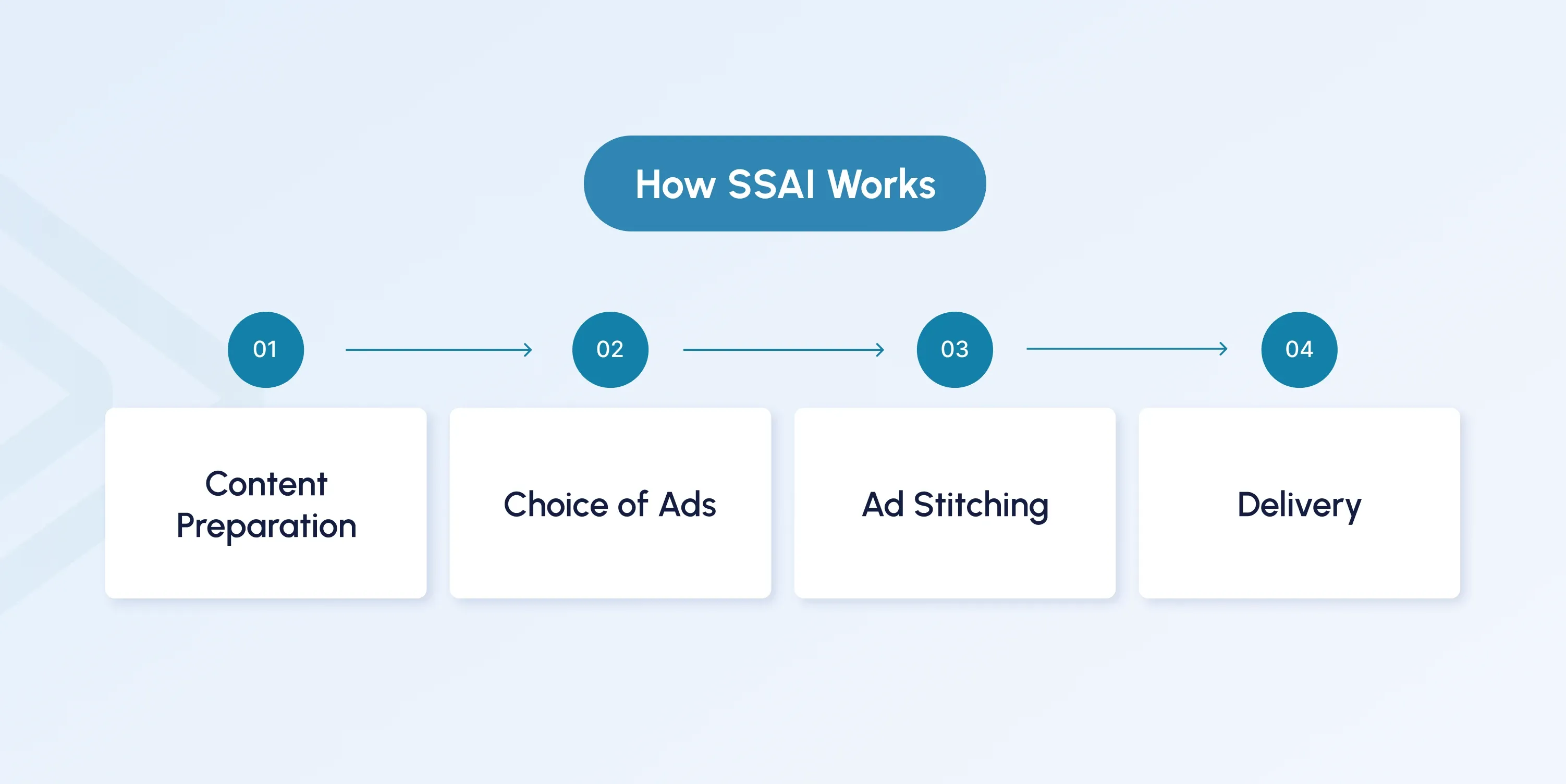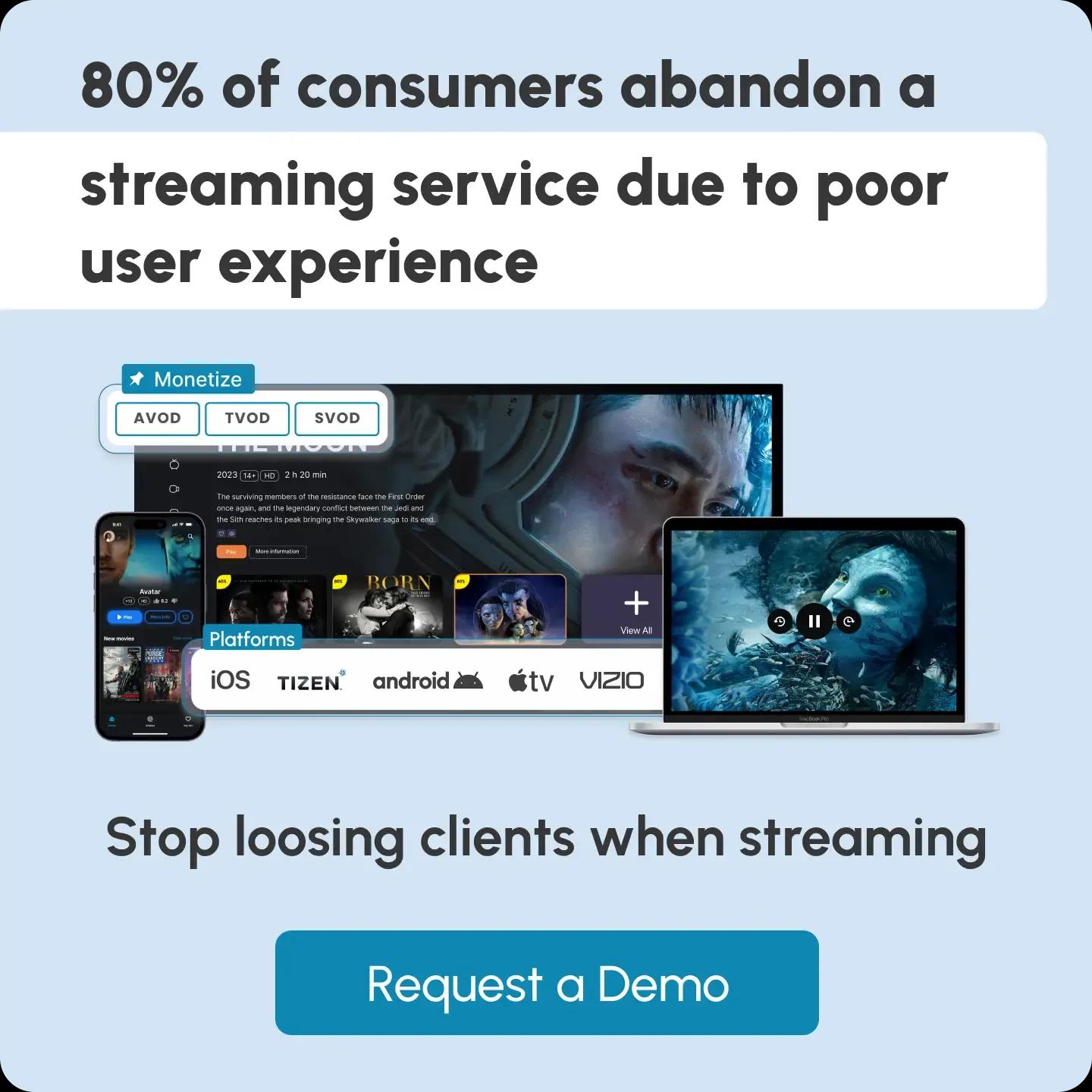
What is SSAI? A Guide to Server-Side Ad Insertion
The biggest streaming challenge is to deliver a seamless viewing experience while maximizing ad revenue. That’s where server-side ad insertion (SSAI) comes in. It’s a technique that embeds ads directly into video streams for smooth playback and personalized delivery.
Since SSAI presents ads as part of the video itself, they’re impervious to ad blockers and guarantee constant playback quality, in contrast to conventional client-side advertisements that can be skipped or stopped.
This guide explores the meaning of SSAI, its benefits, and how it compares to client-side ad insertion. Let’s jump in.
What is Server-Side Ad Insertion (SSAI)?
 SSAI (Server-Side Ad Insertion), also known as dynamic ad insertion (DAI), is a technology that inserts advertisements into streaming content directly from the server, rather than on the viewer's device.
SSAI (Server-Side Ad Insertion), also known as dynamic ad insertion (DAI), is a technology that inserts advertisements into streaming content directly from the server, rather than on the viewer's device.
Unlike client-side ad insertion, where ads are loaded separately on the user's device, SSAI combines ads and video content into a single seamless stream. This happens on the server before the stream reaches the viewer.
Server-side ad insertion:
- Ensures a smooth, buffer-free viewing experience.
- Significantly reduces the impact of ad blockers.
- Enables precise ad targeting and performance tracking.
For OTT platforms, SSAI is a groundbreaking development. It allows the delivery of high-quality, personalized ads without interrupting the viewing experience.
How Server-Side Ad Insertion Works
 Server-side ad insertion (SSAI) is a seamless process that integrates ads into video streams before they’re delivered to users. Here’s how it works step by step:
Server-side ad insertion (SSAI) is a seamless process that integrates ads into video streams before they’re delivered to users. Here’s how it works step by step:
Step 1. User Request
When a user requests video content, the SSAI system retrieves the stream from the content server.
Step 2. Ad Selection
The system then communicates with an ad server to select the most relevant ads. These ads are chosen based on factors like user demographics, viewing history, content context, or location, ensuring a personalized and targeted experience.
Step 3. Ad Stitching
The selected ads are stitched into the video stream in real time. This process occurs on the server, creating a single, continuous stream that includes both the content and the ads.
Step 4. Flawless Playback
The integrated stream is delivered to the user’s device, ensuring smooth transitions between the video and ads without buffering or interruptions. By embedding the ads into the content flow, server-side ad insertion minimizes the risk of ad blocking.
Step 5. Performance Tracking
SSAI tracks metrics like viewer engagement and ad impressions, providing advertisers and platform owners with comprehensive performance data to refine strategies.
Benefits of Server-Side Ad Insertion
For OTT systems and advertisers, server-side ad insertion has several advantages. By including ads right within video streams, it offers a more enjoyable viewing experience while also optimizing content monetization.
Here are the main benefits of SSAI:
Seamless Ad Integration
SSAI guarantees flawless transitions free from buffering or disturbances by stitching ads immediately into the video stream. This improves the entire viewing experience by eliminating the sudden gaps that could arise with client-side ad insertion methods.
Bypasses Ad Blockers
Since ads are embedded within the video stream, SSAI effectively avoids detection by ad blockers. This guarantees higher ad visibility, ensuring OTT platforms and advertisers maintain reliable revenue streams.
Personalized Ad Delivery
Using viewer data, SSAI delivers highly targeted ads tailored to user preferences, location, and behavior. This personalized approach increases ad relevance, boosts engagement, and enhances OTT marketing campaigns.
Improved Viewer Experience
Unlike traditional approaches, server-side ad insertion minimizes disruptions by offering a smooth, uninterrupted viewing experience. This reduces the risk of viewers abandoning content due to poorly managed ad breaks. It can therefore also boost audience retention rates.
Comprehensive Analytics and Reporting
SSAI enables precise tracking of ad performance metrics, including impressions, click-through rates, and viewer engagement. Like OTT analytics, this data empowers OTT platforms and advertisers to optimize future campaigns and increase their returns on investment (ROI).
Scalability
Being able to handle large-scale ad delivery, SSAI is ideal for high-traffic events such as live streams, sports, and other content that millions of users may access simultaneously.
Optimized for Live Streaming
Having large scalability, SSAI advertising makes sure that the placement of ads won’t disrupt live broadcasts.
Server-Side Ad Insertion vs. Client-Side Ad Insertion
To completely understand what SSAI is, let’s also refer to CSAI, another ad insertion technology. With this method, ads are loaded and played directly on the user's device (client) during video playback.
Here’s a comparison table to better understand the key differences between SSAI and CSAI.
| Feature | SSAI | CSAI |
|---|---|---|
| Ad Integration | Ads are stitched into the video stream on the server. | Ads are loaded separately on the user's device. |
| Ad Blocking | Harder to block because ads are part of the content stream. | Easier to block using ad blockers. |
| Playback Experience | Very smooth, with no buffering or additional loading time. | Can cause buffering or playback delays when ads load. |
| Personalization | Ads are personalized based on server-side data. | Ads are personalized using client-side cookies and data. |
| Scalability | More scalable, especially for live events, as the server handles the workload. | Less scalable because each client handles ad loading. |
| Analytics | Limited to server-side data and may lack detailed user interaction metrics. | Provides more detailed user interaction metrics like click-through rates. |
| Implementation | Requires more sophisticated server infrastructure. | Easier to implement, but may impact user experience. |
SSAI ad insertion offers a better user experience, providing a smoother and uninterrupted viewing experience that is resistant to ad blockers, making it ideal for high-quality streaming platforms and live events. CSAI ad insertion may be less preferable because of its buffering issues and vulnerability to ad blockers.
The Differences in Operating
- Ad Delivery Method: To provide a seamless viewing experience, SSAI combines advertising with the video stream before it reaches the viewer's device. Through the client's equipment, CSAI provides ads where the video player retrieves and inserts ads independently. This can lead to possible buffering or disruptions.
- Ad Blocker Resistance: To ensure better ad delivery rates, SSAI embeds ads directly within the video content, making them difficult to block or stop. On the other hand, CSAI is susceptible to ad blockers, which can significantly decrease ad impressions and, gradually, ad-generated income.
- Personalization and Targeting: Both systems provide ad customization, but SSAI often excels in delivering seamless, targeted advertising due to its direct interaction within the video stream. CSAI allows dynamic ad targeting but may present challenges, such as mismatched or skipped commercials.
- Complexity and Cost: An SSAI platform can be more complex and costly to set up due to the infrastructure required to process and stitch ads. CSAI is simpler and less expensive but sacrifices reliability and viewer satisfaction.
Key Challenges in Server-Side Ad Insertion
Although OTT systems gain a lot from server-side ad insertion, they also face difficulties. Understanding and addressing these challenges enables you to control and maximize the ad distribution process.
1. Implementation Complexity
Implementing SSAI involves extensive technological infrastructure and knowledge. The process of stitching ads smoothly into video streams demands coordination across numerous systems. These include video servers, ad servers, and analytics tools, which can be challenging for some platforms.
Solution: Partner with experienced OTT service providers that offer scalable, ready-to-deploy solutions to minimize technical hurdles.
2. Latency Issues
Server-side ad insertion offers better ad delivery. But latency still exists, particularly in highly sought-after ad impressions or underdeveloped networks. The goal is low latency, since high latency can lead to delays or buffering that affect the user experience and frustrate viewers.
Solution: Optimize server performance, use content delivery networks (CDNs), and pre-cache ad assets to minimize latency.
3. Ad Inventory Management
SSAI systems must handle diverse ad creatives, formats, and targeting options across multiple platforms. Poor synchronization can result in mismatched or improperly timed ads, which leads to reduced ad effectiveness.
Solution: Implement an advanced content management system that ensures accurate ad delivery and dynamic server-side ad insertion.
inoRain can help you do this. Contact us to learn more.
4. Cross-Platform Compatibility
Delivering ads seamlessly across OTT devices like smartphones, smart TVs, and computers can be complex due to variations in screen sizes and device capabilities.
Solution: Use adaptive ad technology and rigorous testing to ensure compatibility and maintain a consistent viewing experience across all platforms.
5. Monetization and Reporting
SSAI’s server-side nature can complicate real-time tracking of ad performance and revenue reporting. These delays can then hinder the ability to measure ad effectiveness and adjust strategies quickly.
Solution: Integrate analytics solutions with real-time reporting and comprehensive performance data to maximize monetization opportunities.
Best Practices for Implementing SSAI
Successfully integrating server-side ad insertion (SSAI) on your OTT platform requires strategic planning and adherence to best practices. These tactics will help ensure smooth and frictionless ad delivery, a better user experience, and maximum revenue generation.
Choose the Right SSAI Solution
Not all SSAI technologies are created equal, so selecting the one that best fits your platform’s needs is critical.
- Evaluate Scalability: Ensure your chosen solution can handle diverse content types and meet increasing viewer demands.
- Check Integration Capability: Opt for a server-side ad insertion platform that easily integrates with your existing video infrastructure.
- Ad Format Compatibility: Your chosen solution should support various ad formats without compromising playback quality.
Boost Ad Relevance with Personalization
Use SSAI’s ability to deliver customized ads based on user data like location, viewing habits, and demographics.
- Focus on Data-Driven Targeting: Use insights to display ads that resonate with your viewers. This will help you boost engagement and, therefore, revenue.
- Balance Personalization and Privacy: Ensure compliance with regulations like GDPR and CCPA to protect user data while delivering relevant ads.
Monitor Ad Performance in Real-Time
Real-time monitoring is essential for optimizing ad delivery and addressing issues promptly.
- Track Key Metrics: Use analytics tools to measure ad fill rates, completion rates, and viewer interaction.
- Respond Quickly: Detect and resolve ad distribution issues as soon as possible to maintain smooth operations and maximize monetization.
- Leverage Advanced Analytics: Comprehensive SSAI reports help you refine your OTT business strategies and improve ad effectiveness.
Ensure Cross-Device Compatibility
SSAI delivers ads directly within video streams, but ensuring flawless performance across devices is vital.
- Test Across Platforms: Confirm that ads function seamlessly on smartphones, smart TVs, tablets, and computers.
- Address Device-Specific Issues: Account for varying specifications to avoid technical glitches and maintain a fluid viewing experience.
4 SSAI Use Cases
Dynamic server-side ad insertion may be used in a variety of ways, like live streaming, content streaming, and other OTT services. Below is a list of the most common uses of SSAI.
1. SSAI with DRM Integration
Most streaming platforms that have high-quality content integrate SSAI with DRM systems to protect their content from piracy and unauthorized access. This integration makes the content more secure and gains viewers’ trust.
2. Dynamic Ad Scheduling in Live Streaming
Live streaming events that have a high demand and lots of viewers, such as sports or news broadcasts, often use SSAI for its personalized ad insertion and high quality. This ad monetization method enables platforms to adjust ad schedules dynamically based on real-time changes in inventory or campaign priorities.
3. SSAI in Smart TV Environments
Ad insertions usually encounter the challenge of limited device capabilities. However, SSAI allows streaming services to provide ad-supported content even on smart TVs.
Platforms use media source extensions (MSE) and encrypted media extensions (EME) to manage video playback and ad insertion across different smart TV operating systems. By working closely with manufacturers and conducting extensive testing, SSAI ensures smooth playback, minimizes buffering, and successfully delivers targeted ads to smart TV audiences.
4. Outsourcing SSAI to Third-Party Providers
Many streaming platforms choose to outsource SSAI implementation to specialized third-party providers. These providers use MSE and EME technologies to handle video playback and ad insertion across diverse smart TV ecosystems.
Outsourcing allows platforms to focus on content creation while benefiting from professional-grade ad insertion services that ensure seamless playback, targeted advertising, and a better viewer experience.
Conclusion
By seamlessly embedding ads into video streams, SSAI enhances targeting, improves performance tracking, and minimizes disruptions to the viewer experience.
Its cross-device adaptability and real-time analytics make it a cornerstone of modern OTT advertising strategies. With server-side ad insertion, you can increase your ad monetization, boost ad insertion efficiency, and ensure seamless content delivery across multiple platforms.
As OTT platforms continue to grow, SSAI helps them scale effectively and unlocks maximum revenue potential. The future of OTT advertising lies in leveraging technologies like SSAI to deliver smarter, more engaging ad experiences.
Frequently Asked Questions
Founder / CEO
Andranik is the CEO and Co-Founder of inoRain OTT and the Co-Founder of HotelSmarters, specializing in next-generation streaming technologies and digital transformation for the hospitality sector. He focuses on building innovative, scalable solutions for video delivery, OTT monetization, and data-driven hospitality management. His work bridges technical sophistication with practical business impact, helping organizations modernize their digital ecosystems and improve operational efficiency.

OTT Advertising: Types, Best Practices, and Strategies
Over-the-top (OTT) advertising has transformed how brands connect with consumers.

VPlayed Alternatives: inoRain vs. VPlayed
Explore inoRain as a VPlayed alternative, comparing features, pricing, and OTT solutions to find the best platform for your streaming needs.

Custom OTT Platform Development: How to Start an OTT Business
This guide will walk you through everything you need to know about the OTT platform development.
